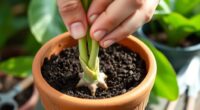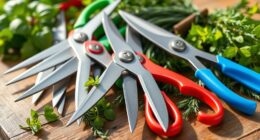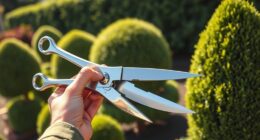To identify tomato hornworms, look for large, green caterpillars about 4 inches long with white diagonal stripes and small black or brown spots. They often blend into foliage, so check under leaves and stems regularly. When hand-picking, wear gloves or use tools, carefully remove the worms, and drop them into soapy water. Keeping your plants healthy and natural predators in mind helps prevent infestations—keep exploring to learn more about effective control methods.
Key Takeaways
- Identify tomato hornworms by their large size, green color, white diagonal stripes, and black or brown spots.
- Check undersides of leaves and stems regularly for hornworms and signs of damage.
- Use gloves or tools to gently grasp and remove hornworms to avoid skin irritation or bites.
- Drop detected hornworms into soapy water or dispose of them carefully to prevent re-infestation.
- Promote natural predators like parasitic wasps and birds to help control hornworm populations naturally.
Recognizing the Appearance of Tomato Hornworms
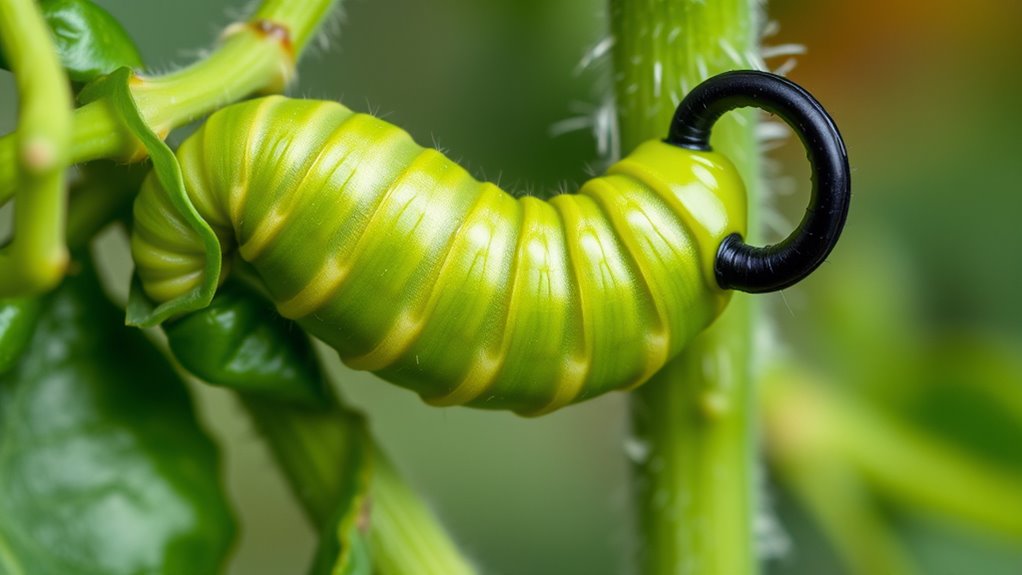
Tomato hornworms are large, green caterpillars easily spotted on tomato plants. They typically reach about 4 inches long, with a robust body and distinctive white diagonal stripes along their sides. Their coloration can vary from bright green to bluish-green, helping them blend into the foliage. You might also notice small black or brown spots scattered across their bodies. Recognizing these features helps you identify them early before they cause significant damage. Natural predators like birds, wasps, and beneficial insects often keep hornworm populations in check, reducing the need for chemical controls. If you prefer, you can manually remove these caterpillars to protect your plants. Being familiar with their appearance allows you to take timely action, whether through natural methods or targeted chemical controls when necessary. Additionally, understanding pest management techniques can help you develop an effective strategy for controlling infestations.
Signs of Infestation on Your Tomato Plants
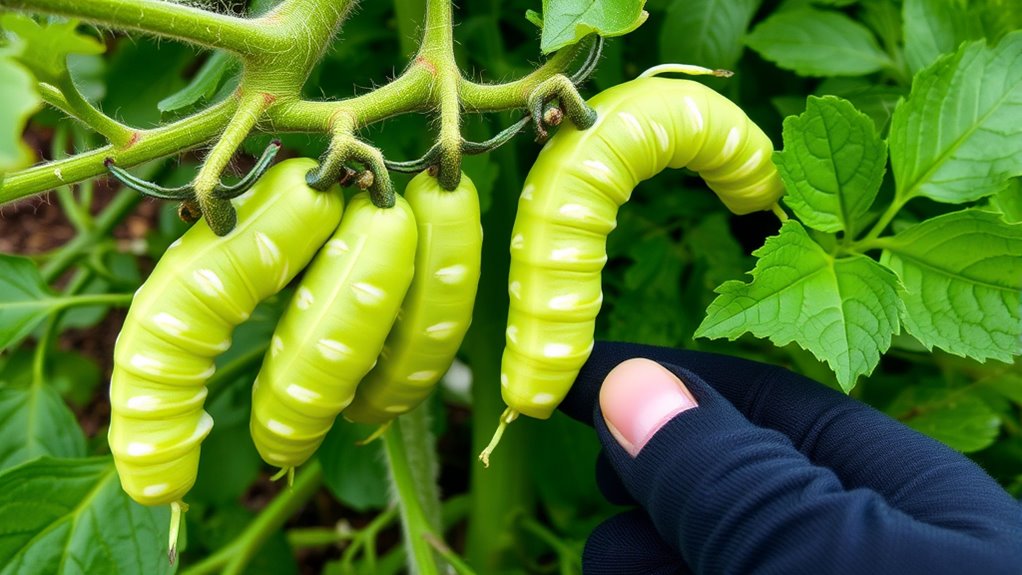
When tomato hornworms infest your plants, early signs become noticeable through specific damage patterns and physical clues. You might see large, irregular holes in leaves or parts of the plant missing altogether. Additionally, silken frass (caterpillar droppings) on leaves indicates their presence. Keep an eye out for the caterpillars themselves, which can grow up to 4 inches long and blend with foliage. Recognizing these signs helps you catch the pest early in its lifecycle. Natural predators, like parasitic wasps, can also leave behind evidence or help control the infestation. Being attentive to these clues allows you to intervene promptly, protecting your tomato plants from extensive damage and disrupting the pest lifecycle before it worsens. Proper pest management techniques can further reduce the impact of hornworms on your garden.
Tools and Safety Precautions for Hand-Picking
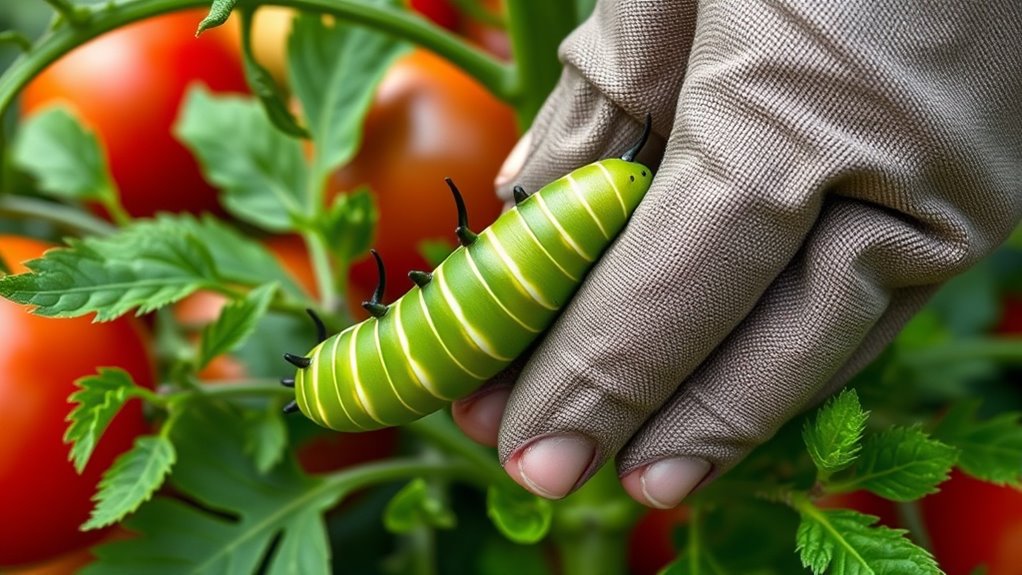
To safely remove tomato hornworms by hand-picking, you should use the right tools and follow essential safety precautions. Use garden tools like gloves, tweezers, or small trowels to handle the worms carefully and avoid direct contact, which can help prevent skin irritation or allergic reactions. Wearing sturdy gloves protects your hands from potential bites or plant residues. Always wash your hands thoroughly afterward to maintain personal safety. Keep tools clean and sharp to reduce the risk of spreading disease. Work in good lighting and be gentle to avoid damaging your plants. If a hornworm is heavily infested or difficult to remove, consider using a container or paper towel to scoop it up. Staying cautious ensures effective removal without harming yourself or your garden.
Step-by-Step Guide to Hand-Picking Hornworms
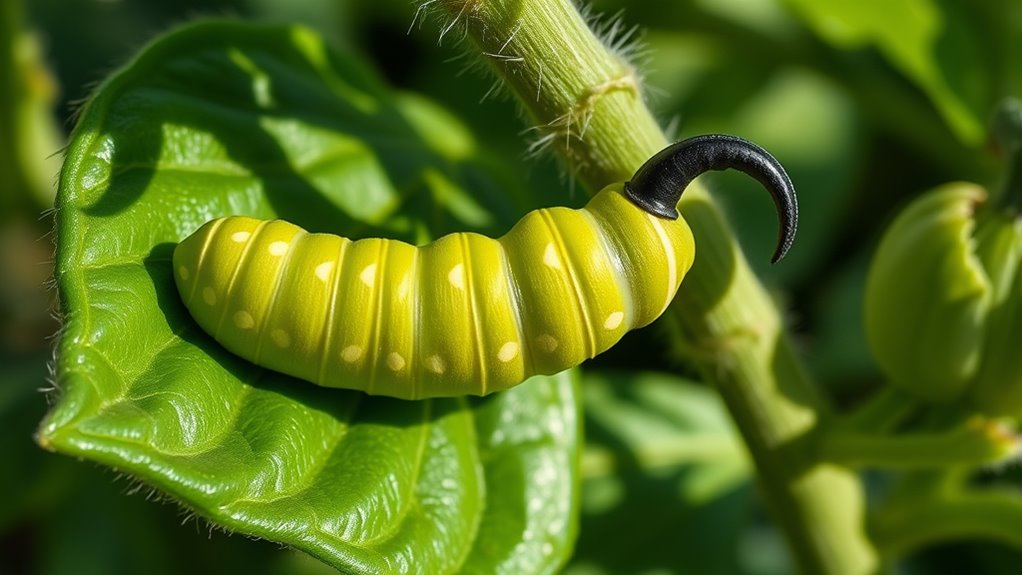
Start by inspecting your plants thoroughly, focusing on the undersides of leaves, stems, and near the fruit where hornworms hide. Once you spot a hornworm, use gloves or a tool to gently grasp it. Here’s how to proceed:
Inspect plants carefully, especially undersides of leaves and stems, to spot and remove hornworms early.
- Carefully remove the hornworm, avoiding damaging surrounding beneficial insects that help control pests naturally.
- Drop the caterpillar into a container with soapy water to kill it safely.
- After removal, consider applying organic pesticides or introducing beneficial insects to prevent future infestations.
- Remember that maintaining a healthy garden environment can support natural pest control and reduce the likelihood of hornworm infestations.
Hand-picking is effective and eco-friendly, reducing reliance on chemicals. Regular inspection keeps your garden healthy and pest-free, making it easier to spot hornworms early. Remember, patience and consistency are key for a successful organic approach.
Tips for Preventing Future Hornworm Problems
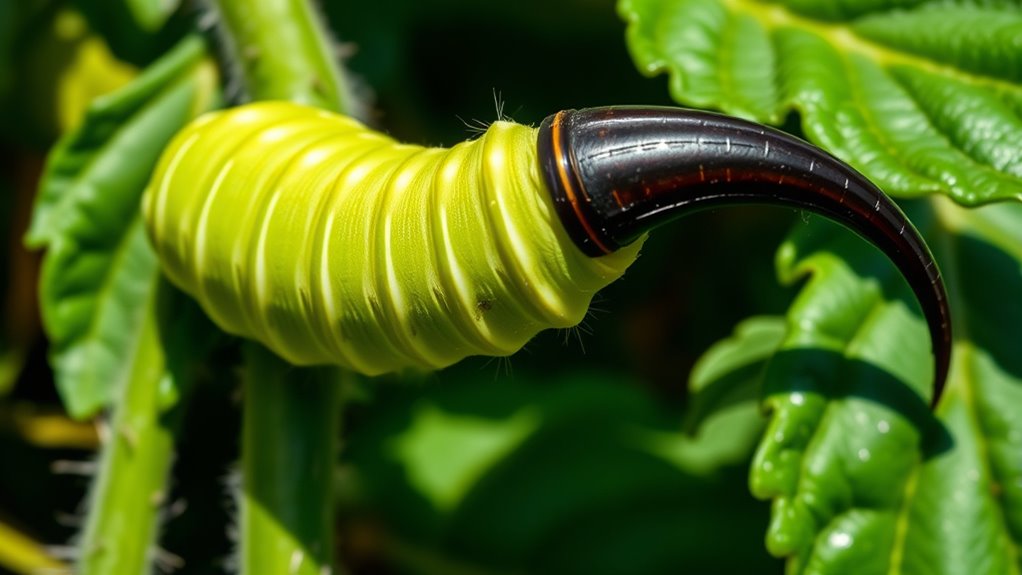
Implementing proactive strategies can substantially reduce the likelihood of hornworm infestations in your garden. One effective method is encouraging natural predators like parasitic wasps and birds, which help keep hornworm populations in check. Avoid planting the same crops in the same spot year after year by practicing crop rotation; this disrupts the hornworms’ life cycle and reduces their habitat. Keep your garden tidy by removing plant debris and weeds where hornworms might hide. Regularly inspecting your tomato plants allows you to catch early signs of infestation before they become a problem. Using natural predators and crop rotation together creates a balanced environment that discourages hornworms from settling in, giving your plants a better chance to thrive without chemical interventions. Additionally, understanding the role of natural predators in pest control can enhance your integrated gardening approach.
Frequently Asked Questions
Are Tomato Hornworms Harmful to Other Garden Plants?
Tomato hornworms mainly target tomato plants, but they can also cause garden crop damage to related plants like peppers and eggplants. While they’re not harmful to unrelated garden crops, their presence signals potential pest issues. To manage them, use effective pest control methods such as hand-picking or natural predators. By staying vigilant, you can prevent extensive damage and keep your garden healthy.
When Is the Best Time of Day to Hand-Pick Hornworms?
The best time to hand-pick hornworms is early evening. During this time, they’re more active and easier to spot on your plants. As the sun sets, they tend to come out of hiding, making it simpler for you to locate and remove them before they cause more damage. By choosing this time, you increase your chances of successfully controlling these pests without the need for chemicals.
Can Natural Predators Control Tomato Hornworm Populations?
Natural predators like beneficial insects can effectively control tomato hornworm populations. You can encourage natural control by attracting these helpful bugs, such as parasitic wasps and beneficial nematodes, to your garden. They prey on or parasitize hornworms, reducing their numbers naturally. While hand-picking is useful, supporting beneficial insects offers a sustainable, chemical-free way to keep hornworms in check, helping your plants stay healthy and productive.
How Can I Distinguish Hornworms From Beneficial Caterpillars?
Distinguishing between beneficial caterpillars and tomato hornworms can be tricky, but paying attention to their features helps. Beneficial caterpillars often have softer, more delicate bodies and may sport different colors or patterns. Tomato hornworms are typically large, green, with a distinctive horn on their rear. By observing these distinguishing features, you can protect helpful caterpillars and target only the harmful hornworms, keeping your garden healthy and harmonious.
Are There Organic Methods to Deter Hornworm Infestations?
You can deter hornworm infestations organically by using companion planting, like marigolds or basil, which repel them naturally. Additionally, applying organic sprays such as neem oil or Bacillus thuringiensis creates a barrier that harms hornworms without chemicals. Regularly inspecting your plants and encouraging natural predators like birds can also help keep hornworm numbers down. These methods work together to protect your garden sustainably.
Conclusion
By regularly inspecting your tomato plants, you can spot hornworms early and keep them in check. Hand-picking remains one of the most effective, chemical-free methods—especially since a single hornworm can eat up to 100 leaves in just a week. With careful attention and swift action, you’ll protect your crop and enjoy a healthy harvest. Stay vigilant; your plants are counting on you to catch those pests before they cause serious damage.

